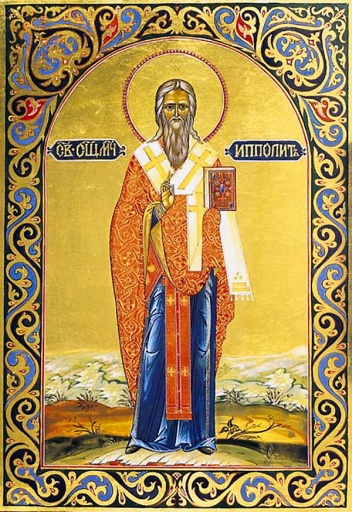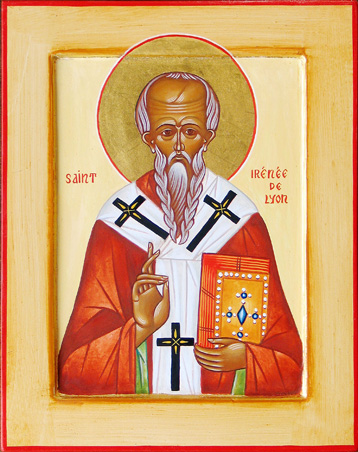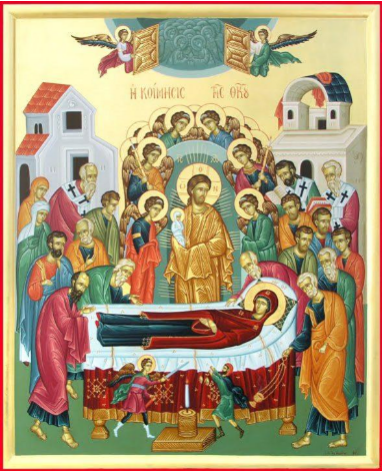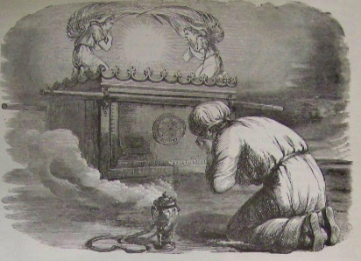 In our previous post, we began a survey of patristic thinking on the Ark of the Covenant, starting with Saint Irenaeus of Lyons. We will continue by moving into the third century.
In our previous post, we began a survey of patristic thinking on the Ark of the Covenant, starting with Saint Irenaeus of Lyons. We will continue by moving into the third century.
While much of his work is lost, the Holy Hieromartyr Hippolytus, presbyter of the Church of Rome in the early third century and likely a student of Saint Irenaeus,1 provides two relevant mentions of the typology of the the Ark. In the only extant fragment from his commentary on Psalm 23, quoted by Theodoret, he strongly links the complete type with Christ, but connects the wood of the Ark with the human nature of the Holy Virgin. O’Carroll asserts that this passage is the first to expose a relationship between the Ark and the Theotokos.
And, moreover, the ark made of imperishable wood was the Saviour Himself. For by this was signified the imperishable and incorruptible tabernacle of (the Lord) Himself, which gendered no corruption of sin. For the sinner, indeed, makes this confession: “My wounds stank, and were corrupt, because of my foolishness.” But the Lord was without sin, made of imperishable wood, as regards His humanity; that is, of the virgin and the Holy Ghost inwardly, and outwardly of the word of God, like an ark overlaid with purest gold.2
Hippolytus’ interpretations of the visions of Daniel and Nebuchadnezzar include an attempt to link the physical dimensions of the Ark with historical time spans, which is irrelevant to the current discussion, but in the course of this diatribe he makes another comment revealing his understanding of the typology of the Ark:
the things that took place of old in the wilderness, under Moses, in the case of the tabernacle, were constituted types and emblems of spiritual mysteries, in order that, when the truth came in Christ in these last days, you might be able to perceive that these things were fulfilled … At that time, then, the Saviour appeared and showed His own body to the world, (born) of the Virgin, who was the “ark overlaid with pure gold,” with the Word within and the Holy Spirit without; so that the truth is demonstrated, and the “ark” made manifest.3
Comments by some scholars seems to indicate a variance in the translation of this passage that makes its meaning unclear to the author. McGuckin, for instance, claims that Hippolytus links the type with the Theotokos.4 It is unclear from the above translation whether the phrase, ‘who was the “ark overlaid with pure gold”’ modifies the noun “virgin” or “saviour,” though in the last phrase, the truth being demonstrated juxtaposed with the ark made manifest seems pretty clearly a reference to the Savior Himself. Migne’s latin rendering clearly makes the phrase parenthetical to the Virgin,5 but an alternative translation by Tom Schmidt seems to be more consistent with the commentary on Psalm 23 quoted above:
… the Savior comes from the Virgin, and then he offered the Ark, his own body, into the world, gilded in pure gold, inside with the Word, outside with the Holy Spirit, so that the truth may be shown and the Ark may be manifested.6
While Hippolytus does make a connection between the Ark and the Theotokos, it seems just as plausible that he saw the Ark in its completeness as a type of Christ. The likelihood that he was a pupil of Saint Irenaeus, who viewed the Ark as a type of Christ, along with the striking similarity between the two saints’ statements, reinforces this position.
In our next post, we will examine what Saint Dionysius of Alexandria had to say about the Ark. If you’re joining us late, you may wish to start at the beginning of our exploration of the Ark of the Covenant.
1 Johann Peter Kirsch. St. Hippolytus of Rome, The Catholic Encyclopedia, Vol. 7, <New York: Robert Appleton Company, 1910>.
2 Translated by S.D.F. Salmond, Fragments from the Scriptural Commentaries of Hippolytus, from Ante-Nicene Fathers, Vol. 5, ed. Alexander Roberts, James Donaldson, and A. Cleveland Coxe, (Buffalo, NY: Christian Literature Publishing Co. 1886) revised and edited for New Advent by Kevin Knight.
3 ibid.
4 John Anthony McGuckin, The Orthodox Church: An Introduction to its History, Doctrine, and Spiritual Culture, (Chichester: Wiley-Blackwell 2010), p. 220.
5 Collected by Joanne Alberto Fabricio and Andrea Gallandio, Operum S. Hippolyti Quæ Supersunt, in Patrologiæ Græcæ, J. P. Migne (1857), vol. 10, column 647.
6 T.C. Schmidt, Hippolytus of Rome: Commentary on Daniel, (Schmidt 2010), p. 141.
 In our
In our 
 In
In